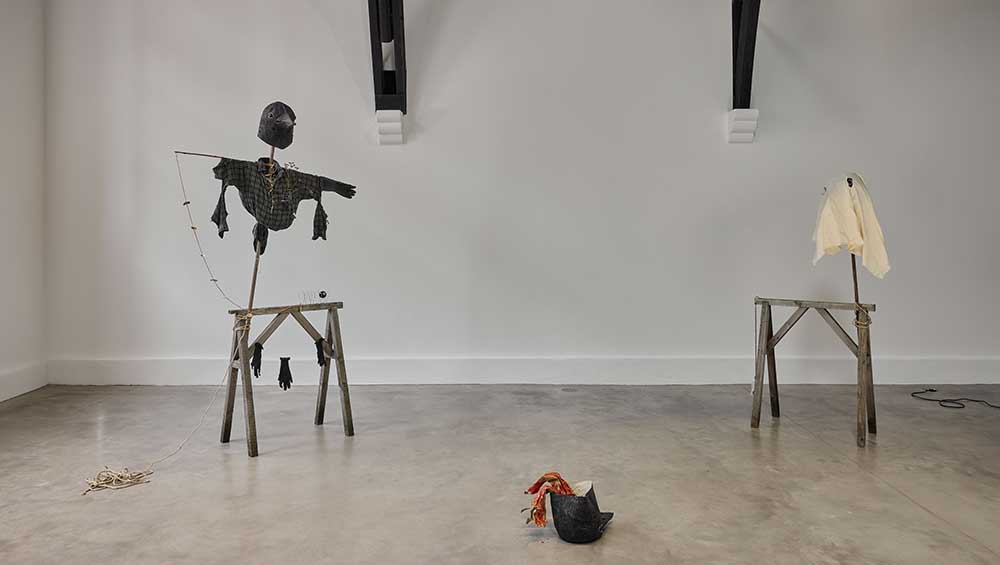
Caspar Heinemann, Sod All, 2025. Installation view at Studio Voltaire. Images courtesy of the artist, Cabinet Gallery, and Studio Voltaire. Photo: Sarah Rainer.
Studio Voltaire, London
7 May – 3 August 2025
by VERONICA SIMPSON
Though somewhat off-grid for London’s mainstream cultural tourists, the discerning art lover knows that Studio Voltaire in Clapham is one of London’s significant art and artist spaces. Not only does it have a 30-year track record of exhibitions in its characterful former chapel gallery, but it also has serious credentials in supporting artists with studios in the converted factory space that sits to the back of this recently and handsomely revamped complex. It echoes east London’s Chisenhale Gallery and Camberwell’s highly regarded South London Gallery in that it is often the first to give emerging artists a show, hand in hand with a residency. That doesn’t always translate to art in the gallery that your average enthusiast can embrace – although often, several years down the line, you see that emerging output blossom into something that feels highly prescient, powerfully of its time. That’s the price, I guess, of being ahead of the curve – and Studio Voltaire gave encouragement early in the careers of Phyllida Barlow, Nicole Eisenman and Monster Chetwynd, some of today’s most celebrated talents.
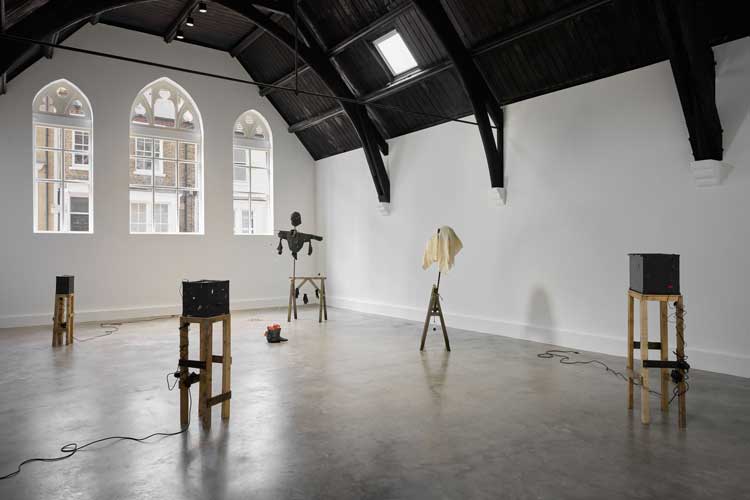
Caspar Heinemann, Sod All, 2025. Installation view at Studio Voltaire. Images courtesy of the artist, Cabinet Gallery, and Studio Voltaire. Photo: Sarah Rainer.
Caspar Heinemann (b1994, London), its current artist on show, comes highly recommended – one of Frieze magazine’s 10 to watch in 2025. The Glasgow-based Heinemann enjoyed a three-month residency in Clapham, to think through his passions and preoccupations, which Frieze magazine listed as “the politics of land, occultism, folk revivalism and sexual countercultures”.
-Caspar-Heinemann_Sod-All_2025_Photo-Sarah-Rainer11.jpg)
Caspar Heinemann, Scarer, 2025. Installation view at Studio Voltaire. Images courtesy of the artist, Cabinet Gallery, and Studio Voltaire. Photo: Sarah Rainer.
His previous shows – the ones that secured my interest in the first place – expressed these themes through reference to folk art and vernacular architecture, evoking imaginative recreations of fictional worlds conjured out of discarded or waste materials in what he has called a “totally dematerialised” practice. Architecture, landscape, poetry, prose and model-making fused into installations that were equal parts disturbing and fascinating at his 2022 show Glorie at Cabinet in London and The Frayed White Collar (2023) at Edouard Montassut, Paris. For the former, he displayed birdhouses on the point of collapse, made from cardboard and wood, held together with string and embellished with dental floss and white acrylic: whimsical and charming but clearly not fit for purpose (though he insisted to Frieze’s reviewer that the show was not about birds). They, in combination with the creepy light installation (Festival of Light, 2022) downstairs, evoked the fragile and fascinating borders – emotional and physical – between comfort and peril that can be found in so many of our dwellings and spaces, from homes to subcultural nightclubs. The Paris show saw Heinemann visualising the US Unabomber Ted Kaczynski as a transgender recluse living in a cabin, using the FBI photographs of his life and mountain abode as part of his “documentation”, and reproducing a conversation Kaczynski allegedly had in his youth with a psychiatrist with whom he shared that he might have preferred to be female. The show included a letter from Heinemann to a fictional friend, Ed, about what he would like to do in his show, but with chunks of many sentences redacted. One of the more disturbing aspects of this show was not knowing where Heinemann’s point of empathy was with Kaczynski, as the artist gave nothing away. Is the art that makes us uncomfortable the most powerful? In order to bind me with its spell, I would say art has to be interlaced with humour, wit, insight or beauty as well as darkness.
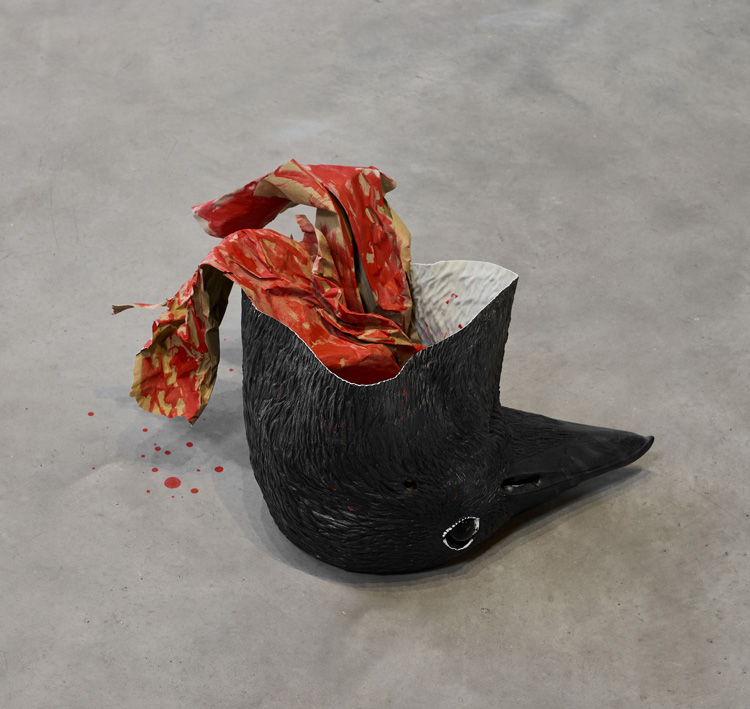
Caspar Heinemann, Sod All, 2025. Installation view at Studio Voltaire. Images courtesy of the artist, Cabinet Gallery, and Studio Voltaire. Photo: Sarah Rainer.
But even anticipating some discomfort, I am brought up short by the bleak, nihilistic mood of Heinemann’s show at Studio Voltaire. A cardboard blackbird’s decapitated head lies, filled with red, fabric gore, on the floor; there is a hooded bird’s head on the end of what could be interpreted as a wooden “spike” – of the kind that the severed heads of rebels or enemies might have appeared on around a city’s walls, in medieval times - and a kind of bird scarecrow (Scarer, 2025) with its stuffing hanging out. Birds, which he may not have intended as the focus for his Glorie show, have moved centre stage for this one, including a flock of upside-down mallards adorning the chapel ceiling. There are also three glass tanks that have been turned into light boxes, their electric cords trailing on the floor, with the contents – even the tinted light inside - almost entirely obscured by thick black gaffer tape in which the boxes are enveloped. The chapel environment possibly makes this installation all the more gloomy. I am suddenly, starkly aware that the scarecrow’s spindly frame echoes a crucifix, as well as a skeleton.
The introductory panel tells us that the unifying concept for Heinemann’s work here is the word “sod”, in all its multiplicity. Sod, as we are reminded, can mean earth or a person’s native soil. It can also be a term of pity (“poor sod”) or to denote someone as gay (a sodomite). We are also told that, in biblical Hebrew, sod is often interpreted as “a secret”, or “a council or circle, or the highest level of mystical interpretation”.
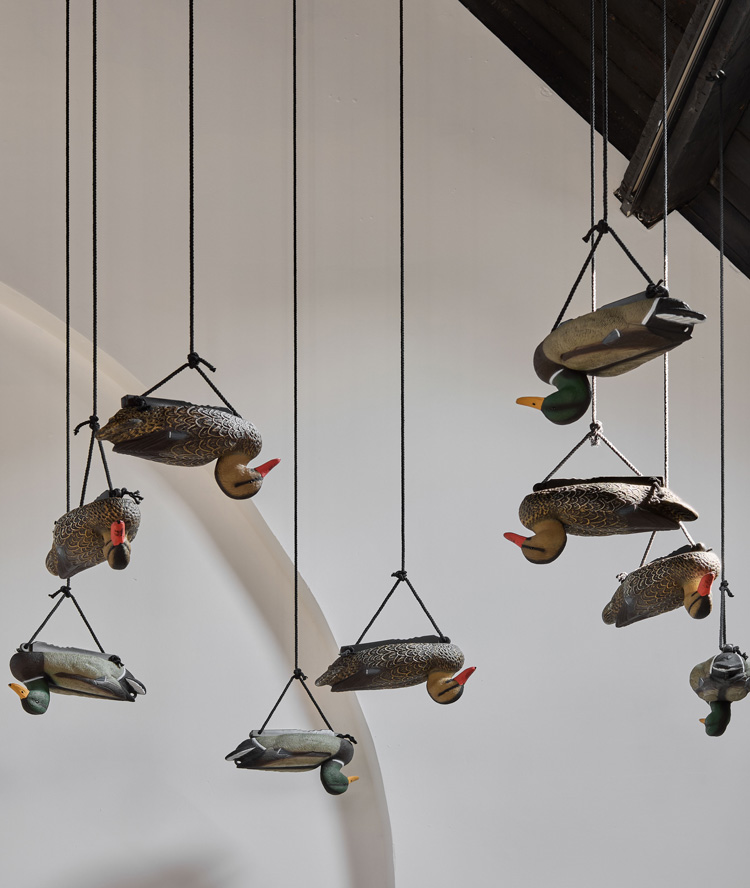
Caspar Heinemann, Dead Ducks, 2025. Installation view at Studio Voltaire. Images courtesy of the artist, Cabinet Gallery, and Studio Voltaire. Photo: Sarah Rainer.
As Heinemann is a published poet, one would expect him to love the layering of words and references, and to have done some deep reading, but the allusions in this show are hardly those he could expect the average visitor to have come across. Art has to tell its own story – if it relies on an elaborate explanation or obscure literary references, surely it is not doing its job very well. Heinemann told Frieze magazine that the plastic duck decoys suspended from the ceiling – Dead Ducks (2025) - were a reference to the “griffin-like illustrations in The Birds’ Head Haggadah”, which, for those who don’t know, is a south German, illustrated Ashkenazi Passover text, from 1300. Surely it would be hard to find a more obscure reference. Though the symbolism lands more fully once we realise these decoys are used for both conservation and hunting purposes - to lure ducks out on to a river, the better to take a shot at them, in the latter case. Their position on the ceiling, again, is supposed to reference the boundary between heaven and Earth … But I only realise this once I have embarked on my research. Should we have to do so much homework to get what an artist is trying to say?
-detail_Sod-All_2025_Installtion-view-at-Studio-Voltaire_Images-courtesy-of-the-artist-Cabinet-Gallery-and-Studio-Voltaire_Photo-Sarah-Rainer26.jpg)
Caspar Heinemann, Time Machine, 2025 (detai). Installation view at Studio Voltaire. Images courtesy of the artist, Cabinet Gallery, and Studio Voltaire. Photo: Sarah Rainer.
The dioramas/tanks are part of a series, Time Machine (2025). The gallery text tells me they evoke “intimacy, warning, warmth and sex”. Not for me, they don’t. I peer very closely into one, and discover that, just visible between the black tape is a tiny model of what looks like a ruined temple, a mini Parthenon, the point of which I speculate is some kind of reference to a golden age of sexual freedom represented by ancient Greek art and culture – the black tape a kind of redacting of this peak moment of historic inclusivity. The wall text confirms that the vitrines contain “Greco-Roman ruins”. I attempt to discern what is inside another, but cannot make out anything except what could be grey rubble. I give up trying to decode the third one.
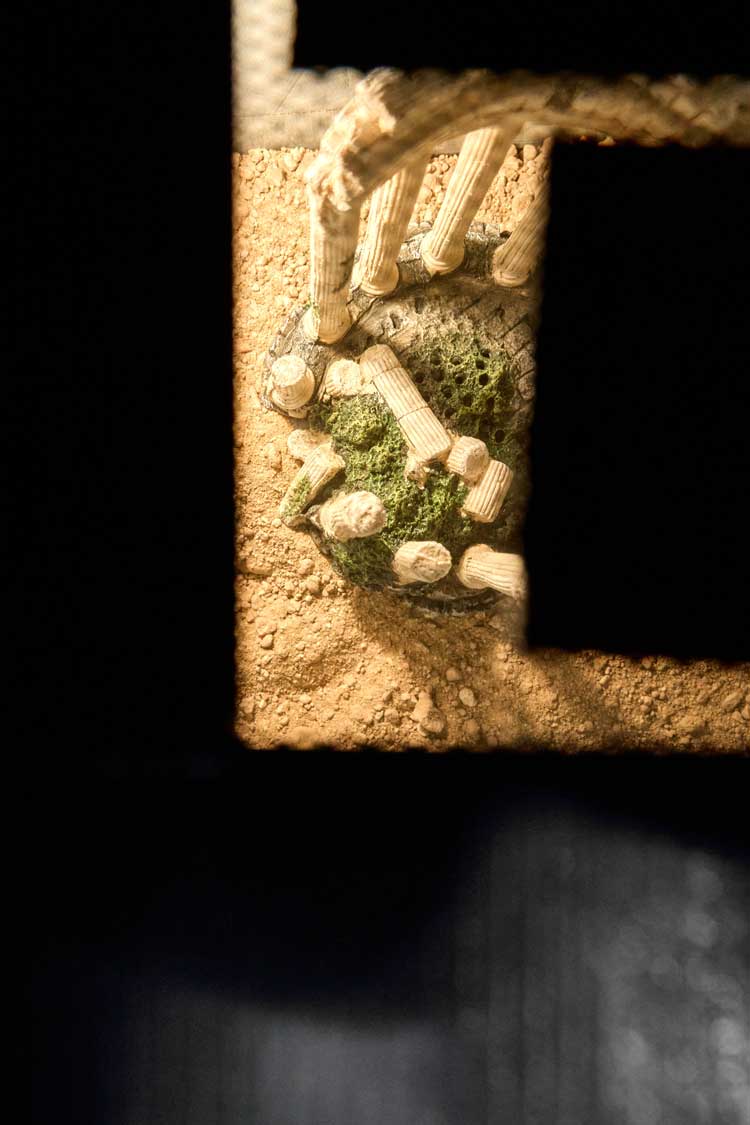
Caspar Heinemann, Time Machine, 2025. The temple inside one of the vitrines. Installation view at Studio Voltaire. Images courtesy of the artist, Cabinet Gallery, and Studio Voltaire. Photo: Sarah Rainer.
In seeking further clarification, I discover that, just as Heinemann began his residency here, he found out that a close friend had died. Suddenly, this installation makes sense as the work of an artist in the first stages of mourning, when rage and denial are often the strongest emotions. That bleak, apocalyptic, end-of-days quality it conjures feels authentic to such an experience. Maybe we should mark this down as work in progress, a point of connection with deep spiritual and emotional distress. “Sod all”, its title, seems all the more apt, summoning the feeling of futility and despair that arises when a loved one – and a young one at that – dies. Never mind the art, as one human empathising with another, I am hoping he is now on the pathway to resignation, which, according to the classical recovery path, usually leads to acceptance and resilience.
Voltaire’s residency and support has been transformational in the past – Eisenman said it was during her 2012 residency here that her work transitioned from painting to sculpture. Heinemann’s work so far has displayed a promising richness of emotional, cultural, political and material intensity. Who knows, maybe this will prove a seminal exhibition on his pathway to a new clarity around thematic and material expression, as happened with Eisenman. I would rather not entertain the alternative reading: that we will come to see in time that this show expresses the future – ours/contemporary art’s – as truly this bleak.